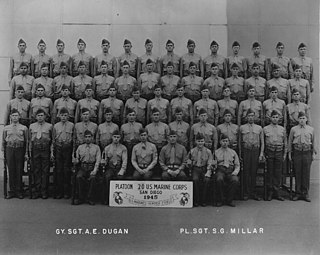Related Research Articles

The United States Army (USA) is the land service branch of the United States Armed Forces. It is one of the eight U.S. uniformed services, and is designated as the Army of the United States in the U.S. Constitution. The oldest and most senior branch of the U.S. military in order of precedence, the modern U.S. Army has its roots in the Continental Army, which was formed 14 June 1775 to fight the American Revolutionary War (1775–1783)—before the United States was established as a country. After the Revolutionary War, the Congress of the Confederation created the United States Army on 3 June 1784 to replace the disbanded Continental Army. The United States Army considers itself to be a continuation of the Continental Army, and thus considers its institutional inception to be the origin of that armed force in 1775.

A battalion is a military unit, typically consisting of 300 to 1,000 soldiers commanded by a lieutenant colonel, and subdivided into a number of companies. In some countries, battalions are exclusively infantry, while in others battalions are unit-level organizations.
A company is a military unit, typically consisting of 80–250 soldiers and usually commanded by a major or a captain. Most companies are formed of three to seven platoons, although the exact number may vary by country, unit type, and structure.

A platoon is a military unit typically composed of two or more squads, sections, or patrols. Platoon organization varies depending on the country and the branch, but a platoon can be composed of 50 people, although specific platoons may range from 10 to 100 people. A platoon is typically the smallest military unit led by a commissioned officer. The platoon leader is usually a junior officer—a second or first lieutenant or an equivalent rank. The officer is usually assisted by a platoon sergeant.

Sergeant is a rank in many uniformed organizations, principally military and policing forces. The alternative spelling, serjeant, is used in The Rifles and other units that draw their heritage from the British light infantry. Its origin is the Latin serviens, 'one who serves', through the French term sergeant.
The Combat Capabilities Development Command (CCDC) Soldier Center, now CCDC SC was formerly the United States Army Natick Soldier Research, Development and Engineering Center, and is a tenant unit of the United States Army Natick Soldier Systems Center (SSC), or Soldier Systems Center Natick. CCDC SC is a military research complex and installation in Natick, Massachusetts charged by the U.S. Department of Defense with the research and development of food, clothing, shelters, airdrop systems, and other servicemember support items for the U.S. military. The installation includes facilities from all the military services, not just the Army, and is so configured to allow cross-service cooperation and collaboration both within the facility and with the many academic, industrial and governmental institutions in the Greater Boston Area.

The 94th Division was a unit of the United States Army in World War I, and of the Organized Reserve Corps in 1921 until 1942.

A combat medic, or healthcare specialist, is responsible for providing emergency medical treatment at a point of wounding in a combat or training environment, as well as primary care and health protection and evacuation from a point of injury or illness. Additionally, medics may also be responsible for the creation, oversight, and execution of long-term patient care plans in consultation with or in the absence of a readily-available physician or advanced practice provider. Combat medics may be used in hospitals and clinics, where they have the opportunity to work in additional roles such as operating medical and laboratory equipment and performing and assisting with procedures.

The United States Army Quartermaster Corps, formerly the Quartermaster Department, is a sustainment, formerly combat service support (CSS), branch of the United States Army. It is also one of three U.S. Army logistics branches, the others being the Transportation Corps and the Ordnance Corps.

The United States Army Airborne School – widely known as Jump School – conducts the basic paratrooper training for the United States Armed Forces. It is operated by the 1st Battalion (Airborne), 507th Infantry, United States Army Infantry School, Fort Benning, Georgia. The Airborne School conducts the Basic Airborne Course, which is open to troops from all branches of the United States Department of Defense, Reserve Officer Training Corps, and allied military personnel.
A field shower is equipment used to provide sanitation and decontamination facilities to military personnel, equipment and vehicles using various liquids, including water in the field of operations. Usually the showering facility is provided by the combat service support elements or decontamination units to combat units deployed away from permanent properties that offer the facilities, or when combat units have been exposed to hazardous chemicals and need to quickly decontaminate themselves.

The Royal Australian Army Ordnance Corps (RAAOC) is the Corps within the Australian Army concerned with supply and administration, as well as the demolition and disposal of explosives and salvage of battle-damaged equipment. The Corps contains clerks, operator supplies, petroleum operators, parachute riggers and ammunition technicians. Members of the Corps are nicknamed Roaches.

The 64th Brigade Support Battalion, nicknamed "Mountaineers," is a United States Army support battalion, assigned to the 3rd Armored Brigade Combat Team, 4th Infantry Division in Fort Carson, Colorado.
A logistics officer is a member of an armed force or coast guard responsible for overseeing the support of an army, air force, marine corps, navy or coast guard fleet, both at home and abroad. Logistics officers can be stationary on military bases or deployed as an active part of a field army, air wing, naval force or coast guard fleet. The responsibilities of Logistics Officers vary, depending on where they are deployed and what tasks they are assigned. In addition, different countries have different roles for Logistics Officers. The main role of these officers remains the same regardless of where they are stationed; to ensure that the force is supplied with enough food, water, fuel, ammunition and other goods and services to complete the task at hand.

528th Support Battalion "The 528th Support Battalion's mission is to provide rapidly deployable CSS and HSS to ARSOF as directed. The 528th Support Battalion's strengths lie in its capability to support ARSOF-unique and low-density weapons and vehicles. The 528th complements [organic] 22 ARSOF CSS, HSS, and signal units. The support battalion consists of a headquarters and main support company (HMSC), three forward support companies and may receive augmentation from Theater Army. As part of Army Special Operations Command the unit, along with the 112th Signal Battalion, is tasked to provide full logistical support to Army Special Operations Forces forming along with several other units what was known as Special Operations Support Command, later reorganized as the 528th Sustainment Brigade (A). The Brigade Troops Battalion includes a wide variety of military occupation specialists: riggers, drivers, medics, mechanics, engineers, fuelers, cooks, etc.
The 59th Quartermaster Company is a bulk petroleum company designed to provide semi-portable storage for 2.5 million US gallons (9,500 m3) of fuel and to provide distribution of fuel to military units within a specified geographic area while deployed overseas. Its secondary mission is to provide an armed military escort to military cargo and civilian trucks during overseas contingency operations. It is a U.S. Army Forces Command combat service support unit stationed at Fort Carson, Colorado under the command of the 68th Combat Sustainment Support Battalion. The 59th has deployed overseas to Algeria, Italy, France, Germany, Korea, Vietnam, Kuwait, Saudi Arabia, Iraq, and Afghanistan. The 59th is the only bulk petroleum company in the Regular Army; all sister units are part of the Army Reserve as of 2011.

The logistical support of the multinational International Force East Timor (INTERFET) peacekeeping mission in 1999 and 2000 involved, at its peak, 11,693 personnel from 23 countries. Of these 5,697 were from Australia, making it the largest deployment of Australian forces overseas since the Vietnam War. INTERFET was unusual in that it was led by Australia, casting the country in a wholly unfamiliar role. The logistics and support areas of the Australian Defence Force (ADF) had been subject to deep cuts in the 1990s. The ADF had not anticipated being committed to such a large peacekeeping mission, and was unprepared to support an Australian force projection of this size, much less act as lead nation of an international coalition.
Supply Technician is the Royal New Zealand Army Logistic Regiment trade responsible for providing Supply & Quartermaster support to the New Zealand Army within New Zealand or overseas.
A brigade support battalion (BSB) is a combat service support battalion of the United States Army. A BSB is an organic part of a brigade combat team (BCT), providing self-sustainment to the BCT for up to 72 hours of high-intensity combat before requiring replenishment. It consists of a headquarters and headquarters company, field maintenance company, distribution company, medical company, and a forward support company assigned to each of the other battalions in the BCT.
A Combat Sustainment Support Battalion (CSSB) is a combat service support battalion of the United States Army. A CSSB can be attached to a sustainment brigade to support the brigade combat teams and support brigades assigned to a corps with maintenance, transportation, supply, field services, and distribution functions. The CSSB is task-organized with the subordinate units necessary to carry out its mission.
References
- 1 2 Infantry. (1998). United States: U.S. Army Infantry School. Volume 89, Number 2. May–August 1999. p. 2
- 1 2 Lindsay, Tim; McLaughlin, James J; Bruneau, Norm. "Force Provider Deploys to Bosnia." Army Logistician, May–June 1997, p. 18-23
- ↑ Ramsey, Andrew; Hope, Michael; "Force Provider Deploys to Central America." Army Logistician, November–December 2001, p. 16-19>
- ↑ The United States Army Modernization Plan. (1998). United States: Department of the Army. L-24
- 1 2 Army RD & A Bulletin. (1993). United States: HQ, U.S. Army Materiel Command. p. 44-45
- 1 2 Quartermaster Professional Bulletin. (1996). United States: U.S. Army Quartermaster School and Center. p. 7-13
- ↑ "News." Army Logistician, January–February 2000, p. 16-19>
- ↑ U.S. Army Weapons Systems 2010-2011. (2010). United States: Skyhorse Publishing. p. 102